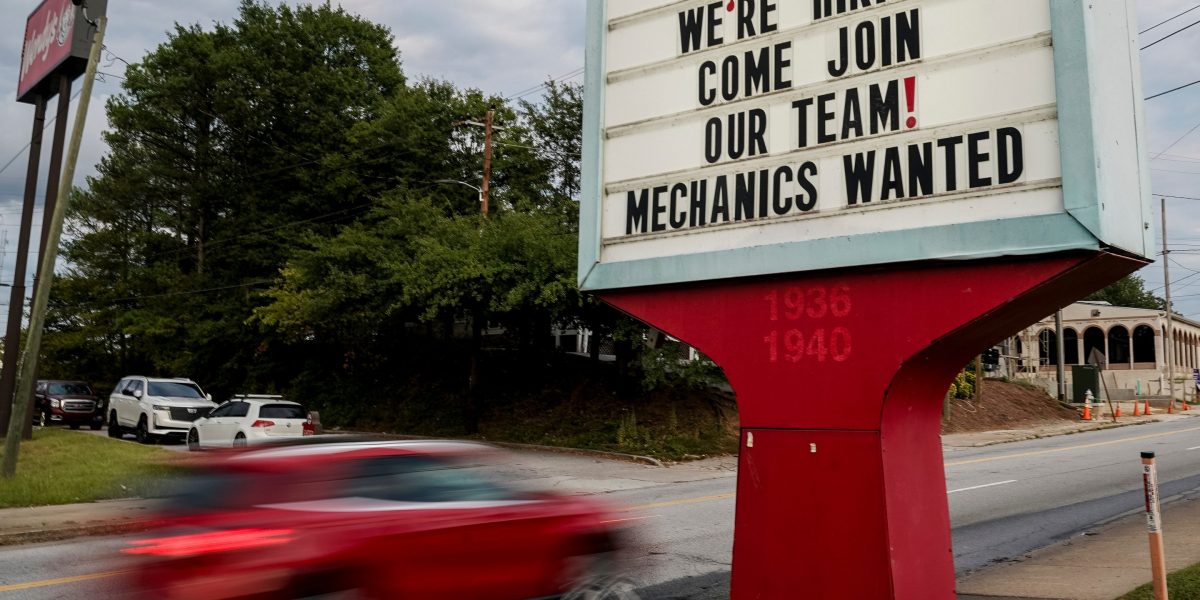
The Federal Reserve cut interest rates for the first time since March 2020 on Wednesday. Stocks balked at the move initially, with all three major U.S. market indices ending the day in the red after a volatile trading session.
While it’s important not to read too far into single-day stock market gyrations, there were a few key investor fears blamed for Wednesday’s wild ride.
First, the Fed’s decision to opt for an outsized 50 basis point rate cut, instead of the more common 25 basis points, was seen by some as evidence that the central bank is “behind the curve”—meaning it should have cut rates months ago to stimulate the economy.
Second, the Fed’s more modest projections for interest rate cuts through the end of 2025—which were well below investors’ expectations for ongoing, aggressive cuts—may have spooked some market participants who fear high rates are slowing the economy too quickly.
On Thursday, however, investors’ fears seemed to have been assuaged. With initial jobless claims falling to their lowest level since May, manufacturing surveys demonstrating more resilience in that sector than anticipated, and a key wage tracker rising, the economy is looking relatively robust.
In fact, the Fed doesn’t look behind the curve at all, according to Eric Wallerstein, chief markets strategist at Yardeni Research.
“If the Fed and the market are extremely worried about unemployment because history rhymes or repeats…if that’s our main worry. And then we got data this morning showing, actually, the manufacturing sector is already improving on its own, unemployment data is the best since before the summer, and the Fed cut 50 basis points, you’re getting a kind of Nirvana, right?” he told Fortune. “The Fed is cutting into one of the stronger economies we’ve seen in years”
3 signs of a surprisingly resilient U.S. economy
Initial jobless claims
Investors have long feared that a sustained period of elevated interest rates will slow the economy, and eventually spark a string of layoffs. And for a time, they had some evidence to back their theory, with jobless claims steadily rising.
But this week was different. Initial jobless claims, one of the best measures of layoffs, came in at 219,000 for the week ending September 14. That’s the lowest level since May, and down from 231,000 the prior week.
Meanwhile, unemployment rolls shrunk to levels last seen in early June. Insured unemployment, or the number of people actively receiving unemployment benefits, dropped 14,000 to 1,829,000 for the week ending September 7.
“The first economic data point since the ‘jumbo’ rate cut should please the Fed,” Chris Larkin, managing director of trading and investing at E*TRADE from Morgan Stanley, told Fortune of the data via email. “Lower-than-expected jobless claims won’t raise any immediate concerns about the labor market slowing too much.”
Wallerstein echoed that view. “Initial weekly [jobless] claims and continuing [jobless] claims now are falling…people were worried the climb would continue. That’s not the case. There’s no slow down, recession evidence in the layoff data.”
Manufacturing surveys
The manufacturing sector of the U.S. economy has dealt with headaches for years, from COVID-era supply chain disruptions to rising labor costs. With the sector often seen as a gauge of the economy’s health, weak activity has led to some concerns about the durability of U.S. economic growth.
But, once again, those fears seem to have been tempered of late. On Thursday, the Philadelphia Federal Reserve Manufacturing Business Outlook Survey—a gauge of activity in the manufacturing sector in Delaware, southern New Jersey and central and eastern Pennsylvania—turned positive, bucking its summer downtrend.
This comes after the New York Federal Reserve’s Empire State Manufacturing Survey showed business activity growth in that region for the first time in more than a year on Monday. Yardeni Research’s Wallerstein noted this “improving activity” in multiple manufacturing surveys is a good sign for any bearish investors that were concerned about economic weakness, or the Fed being behind the curve.
Wage growth
After falling consistently from a peak of 9.3% at the start of 2022 to just 3.1% in May of this year, wage growth may also finally be turning the corner. Indeed’s Wage Tracker shows posted wages rose 3.3% in August in what the company labeled a “broad-based” stabilization.
“In short, with posted wages growing at the same steady and sustainable pace we saw before the pandemic, the Indeed Wage Tracker is signaling the U.S. labor market may be settling into a groove,” Indeed economists Nick Bunker and Allison Shrivastava wrote of the data.
Yardeni’s Research’s Wallerstein argued, once again, this data is a good sign for economic growth, and certainly helps assuage investor fears about a deteriorating labor market. “Real wages are rising, beating inflation, and [consumers] are spending,” he said.
Steady wage growth, manufacturing resilience and the lack of evidence of a layoff spike all give Wallerstein confidence that markets can continue their rise, with some intermittent volatility. “As long as the economy is growing stronger than expected, you don’t need to worry,” he said.

